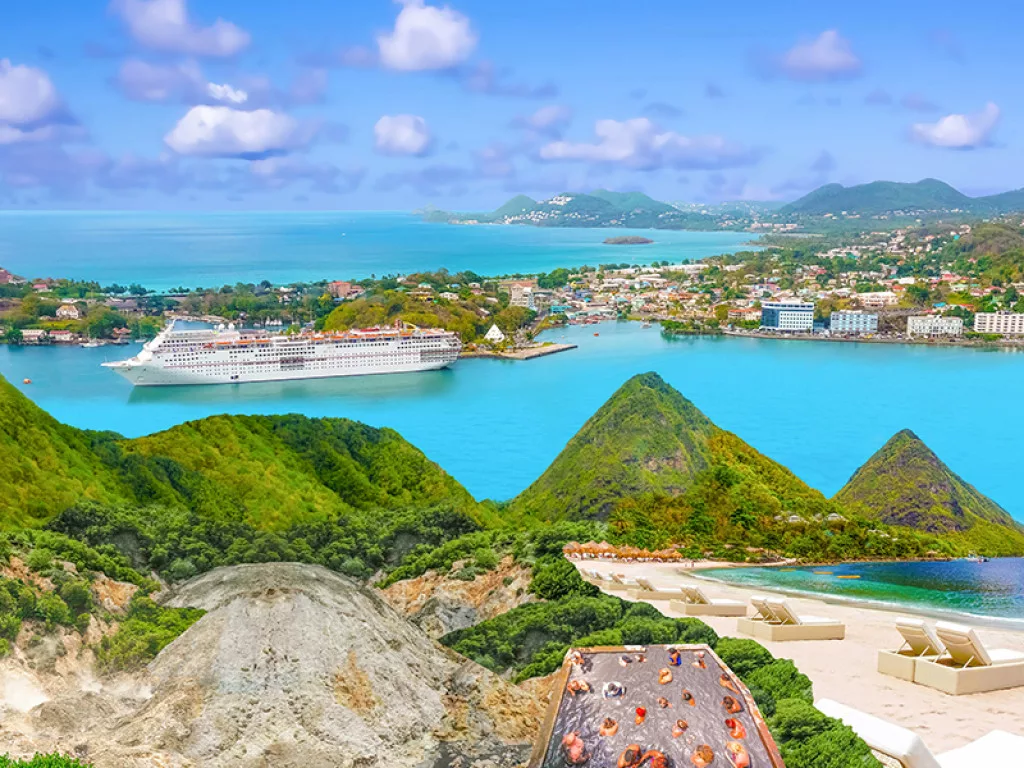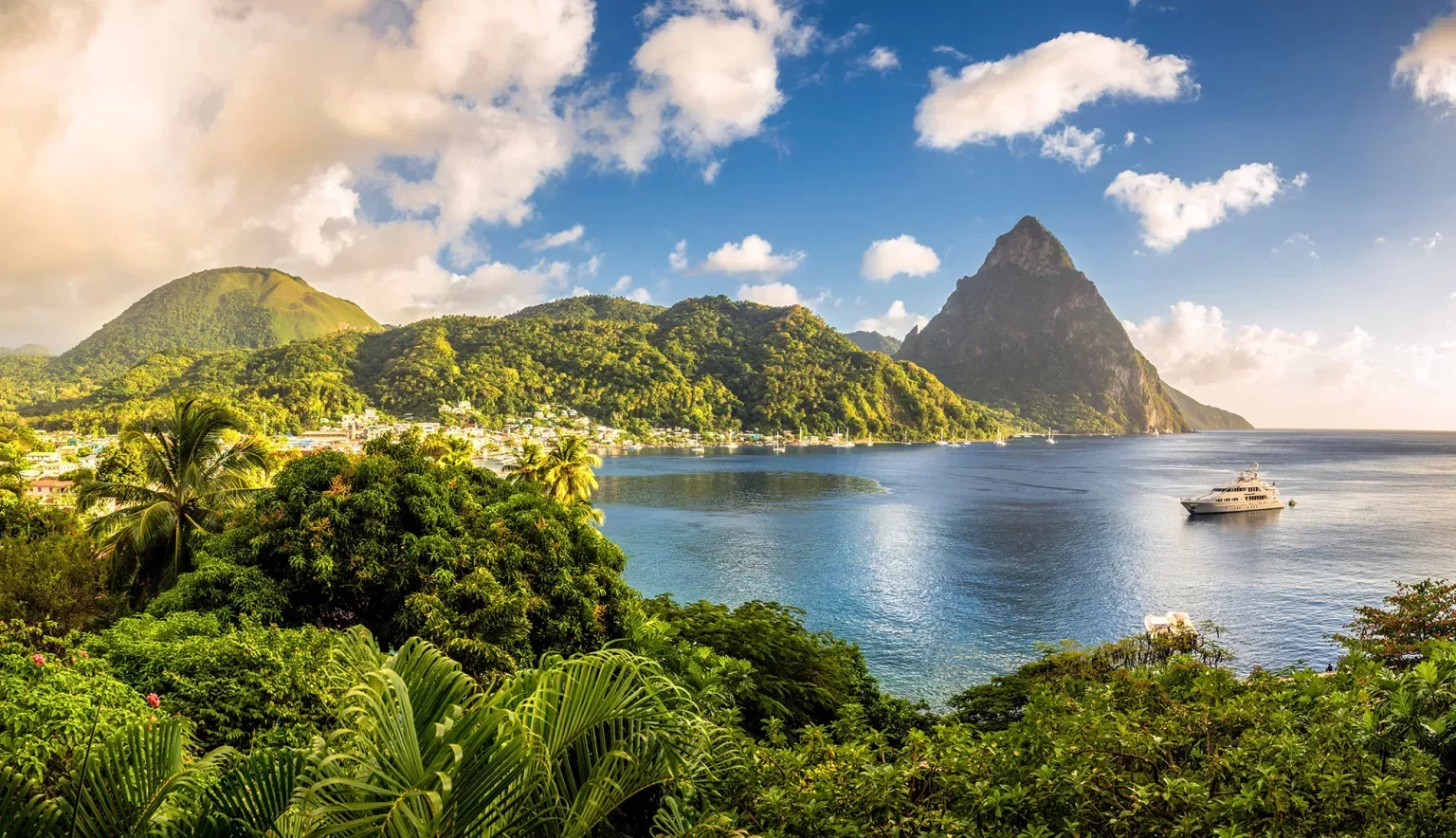Quintessentially Caribbean, Saint Lucia offers recreation and rejuvenation in the tropics. We take a deep dive into the gem of the West Indies as it embraces a future for community-led tourism.
SAINT LUCIA
Much like its endemic national bird, the Saint Lucian Parrot, Saint Lucia is defined by colour – from the sparkling azure of its seas and verdant swathes of jungle, to the kaleidoscopic splendour of its coral reefs and the vibrant jumble of village markets.
Reputed for its beauty, known as the ‘Helen of the West Indies’, and thanks to its location in the path of the north-eastern trade winds, it is not surprising that Saint Lucia has seen many cultures fight to claim this land. First colonised by French settlers in 1650, Saint Lucia finally gained independence in 1979. Remnants of the island’s tumultuous period of colonisation can be found in the military ruins of Pigeon Island National Park, whose shores hold tales of plunder and pirates. Now, Saint Lucia represents a vivid melting pot of cultures, combining Carib, African, Indian, French and English.
This small, paradisiacal isle enjoys a tropical maritime climate. Saint Lucia is split into the livelier northern areas, home to the cruise port-terminal capital of Castries, and the far quieter, rural south. Here you will find a bounty of natural wonders, like the mud baths and natural springs of Soufrière, thundering waterfalls and treks through thick jungle that hosts over 156 bird species. Fertile mountain valleys are carpeted with cocoa plantations that still represent a mainstay of the island’s economy, such as the historic estate of Fond Doux.
Hikers will savour the chance to summit the iconic Pitons – towering twin pyramids of rock rising out of the Caribbean Sea that have long been a national landmark. The surrounding western Caribbean coastline encases secluded coves and stretches of beach whose waters host teeming marine life. Snorkellers and divers worldwide flock to the coral reefs of Anse Chastanet and Grande Anse, where leatherback turtles come to lay their eggs, while whales and dolphins glide further out to sea.
Elsewhere, the island’s famous Creole cuisine is sure to set tastebuds tingling. Weekly ‘Friday Fish Frys’ are not to be missed, as villagers and visitors alike take to the streets to celebrate the start of the weekend over freshly caught fish and lashings of rum, as Calypso and other music drifts in the background. Islanders are known for their hospitality, and as the saying goes, in Saint Lucia, there’s no such thing as a stranger.
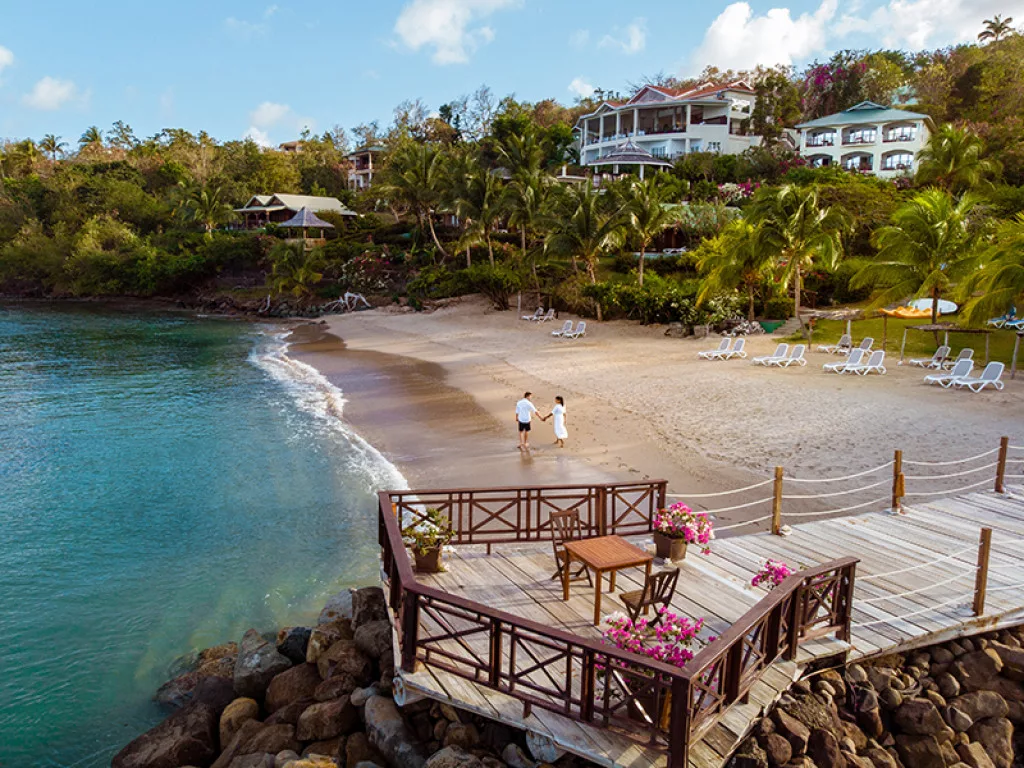
TOURISM INSIGHTS: SAINT LUCIA HOSPITALITY AND TOURISM ASSOCIATION (SLHTA)
For almost 60 years, the Saint Lucia Hospitality and Tourism Association (SLHTA) has operated as the trusted voice behind the island’s tourism industry. We catch up with CEO, Noorani Azeez, as the association engages with major amendments to the local tourism development act, to discuss a future for a community-centred industry.
Q&A WITH NOORANI AZEEZ, CEO, SLHTA
Can you talk us through the origins of SLHTA and its initial vision?
Noorani Azeez, CEO (NA): The association was initially formed in 1963 by a group of 12 hotels who wanted to share with the wider economy and other stakeholders the opportunity that the tourism sector held for investment, employment, and the general development of the country. In 1985, the association expanded to include non-accommodation business operators, including destination management companies, sites and attractions, with a particular emphasis on the food and beverage sector. In 2019, our current board of directors saw how the association was evolving and based on the strengths of the institution, we amended our name from The Saint Lucia Hotel and Tourism Association to the Saint Lucia Hospitality and Tourism Association. We felt that this better reflected our growth and the fact that two-thirds of our members are non-hoteliers.
What are your association’s current goals?
NA: COVID-19 really turned everything upside down, so we have drifted slightly from the strategic plans that we had mapped out for 2019 to 2023. Our primary goals haven’t changed, but they have been reclassified in terms of priority for our organisation. Right now, these include focusing on sustainable economic recovery both for our members and the destination. We are working closely with our members to ensure they are complying with the new protocols of operation that have been created post-2020.
Now, we are also much more deeply involved with civil society. We have literally tripled our resources to support discussions amongst civil society actors that reflect issues affecting our communities and our environment. Many of these issues rose to the fore during the COVID-19 experience, and so we recalibrated our resources to collaborate with stakeholders to ensure we create sustainably healthy communities and protect our environment.
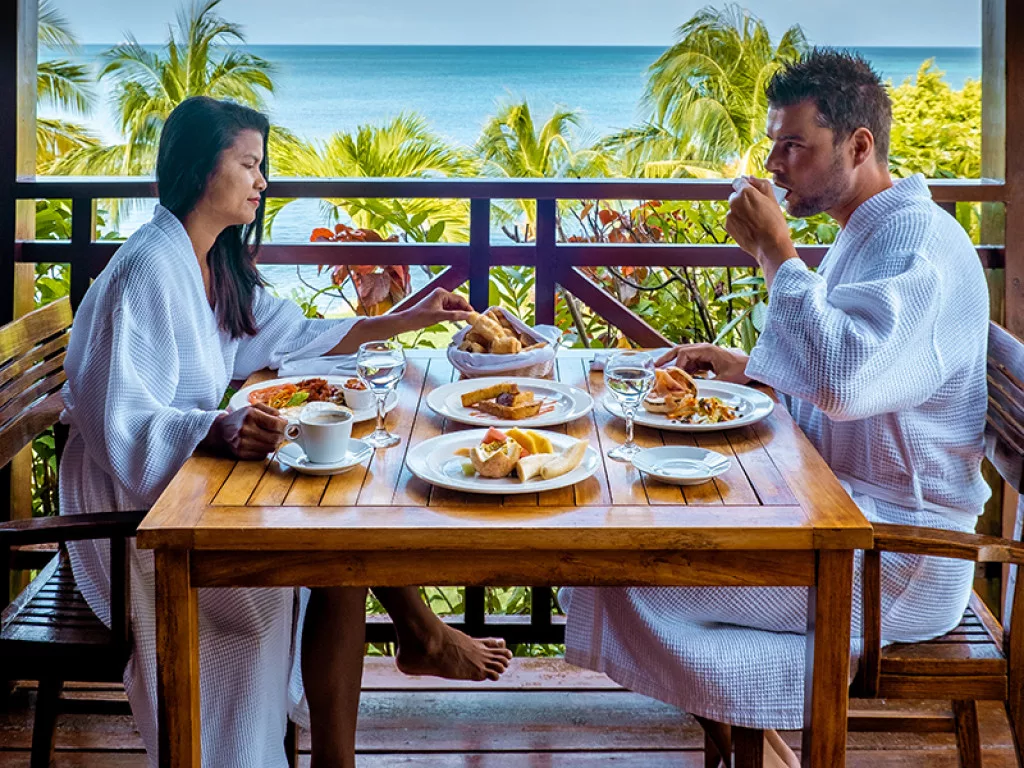
How do you market Saint Lucia as both a business and leisure travel destination?
NA: We lean heavily on the fact that we are first and foremost a leisure destination and we are still piggybacking on the many incredible leisure accolades that we have won over the years – whether it’s bragging about our Nobel Laureates, our unique cultural heritage, or geographic amenities. We have been able to package this all in a very effective way for business travellers too, who may have an opportunity to come here whilst doing business and allow themselves a couple of hours for rejuvenation. That blend has worked fantastically for us.
We support the marketing of Saint Lucia by working closely with our sister association, The Saint Lucia Tourism Authority, and serving on their Marketing Committee. We engage with prospective clients through trade shows and other marketing mediums where we can promote our offerings.
What trends are currently reshaping tourism in Saint Lucia and how are you utilising them?
NA: We’re paying very close attention not only to what our members want, but also our guests and potential visitors, and particularly how those demands are evolving post-2020. For many of us, 2020 will serve as a new benchmark and it has really triggered a national call to action for us to revisit the vision for tourism’s development on the island.
We are focused on ensuring that tourism permeates our communities more effectively. Its benefits need to redound more powerfully to our communities and our environment. Through re-shaping and amending legislation, we are hoping to accommodate this new vision for tourism. This includes implementing new legislation on community-based tourism, allowing groups to make legitimate investments in their communities that have a tourism bias. Our evolving Tourism Development Act also seeks to allow these non-traditional operators access to incentive regimes, financing mechanisms and human resource development – resources that will allow them to not only take the risk of investing in tourism but also to thrive as a business operator.
How is sustainability transforming Saint Lucia’s tourism industry?
NA: Community development has got to be twinned with the development of tourism. We cannot divorce the two from each other. We’ve got to do it in a manner that is sustainable and allows our community-based investors to own assets and equity in the tourism industry. When this type of ownership is created, then it has a positive knock-on effect for environmental sustainability, as seen with communities who are involved in developing the coral reefs and taking guests on diving excursions. These individuals have vested ownership in terms of how the reef is managed, pollution is mitigated, and how waste is disposed of. That type of ownership model allows us to have a very competitive edge when it comes to sustaining our environment.
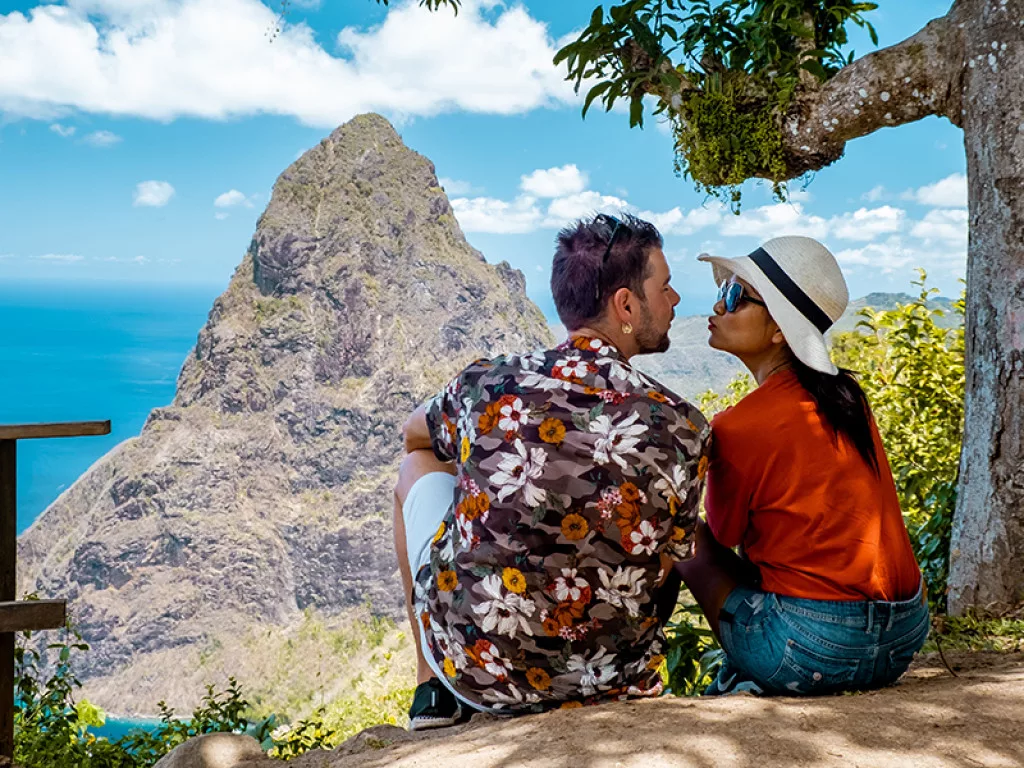
Are you optimistic about the future of the tourism industry in Saint Lucia, particularly with regard to the COVID-19 pandemic?
NA: All of us who are involved in policy-crafting for the destination are very encouraged, both at a regional and an international level. The predictions that were put forward in terms of tourism’s recovery were quite measured and we have been able to surpass that in an admirable way. We have seen tourism continue, as it has done in the past, to demonstrate a high level of resilience and an amazing ability to recover quickly.
We are very optimistic right now, since all of our brands are open for business and we’re in a situation where we are looking at setting up strategic relationships with other sectors on the island to build much more powerful linkages in the supply chain. We are realising that we can rely more on domestic producers to bridge supply chain gaps thereby making our destination more resilient to future shocks. The prospects are excellent for Saint Lucia, and I believe that in the next 12 to 24 months we will see more new brands operating on the island with healthy expansion for existing brands driven by investor confidence.
OUTLOOK RECOMMENDS
SLEEP:
For panoramic romance –
The Ladera Resort boasts a unique location, perched on a volcano ridge 1,000 feet above the Caribbean Sea on the site of the Rabot Estate – one of Soufrière’s oldest and most famous cocoa plantations. Reputed as Saint Lucia’s most romantic getaway, all 37 suites here benefit from a private plunge pool and stunning views of the Pitons. Ladera stands out for its eco-friendly philosophy, with each room constructed from locally harvested tropical hardwoods and its award-winning Dasheene Restaurant, which offers a Farm to Table culinary experience. All furniture is also hand-crafted by Saint Lucian artisans. Although not a beach hotel, a free shuttle service is provided to Malgretout Beach nearby.
For a quiet boutique stay –
Located on the Anse Chastanet Road near Soufrière, Caille Blanc Villa & Hotel offers guests a luxurious stay amidst the most majestic view on the island. An intimate boutique with six bespoke suites including either sea or mountain view, guests can also enjoy a 65-foot infinity pool and waterfall facing the Caribbean Sea and Pitons. Savour authentic cuisine prepared by a Saint Lucian cook and arrange excursions through the team to feed your appetite for adventure. Aside from its tasteful decoration and dedication to exceptional customer service, the hotel sits above the secluded paradise of Snorkel Cove, where untouched coral reef awaits.
For the mind, body and soul –
Promising the ultimate off-grid experience, the Mount Kailash Rejuvenation Centre harnesses the power of nature to deliver optimum health and wellbeing through its all-inclusive wellness retreat. The centre was founded in 2017 by renowned herbal physician the Rt Hon Priest Kailash. Born from a desire to revolutionise the healthcare system, the centre believes in intertwining the rehabilitation process with natural healing. It offers a range of group retreat programmes, including Self Love, Sacred Goddess, and Rising of the Gods. Personalised retreats are also available. A remote natural sanctuary hidden amongst tropical greenery, allow yourself to unwind to the sounds of nature.
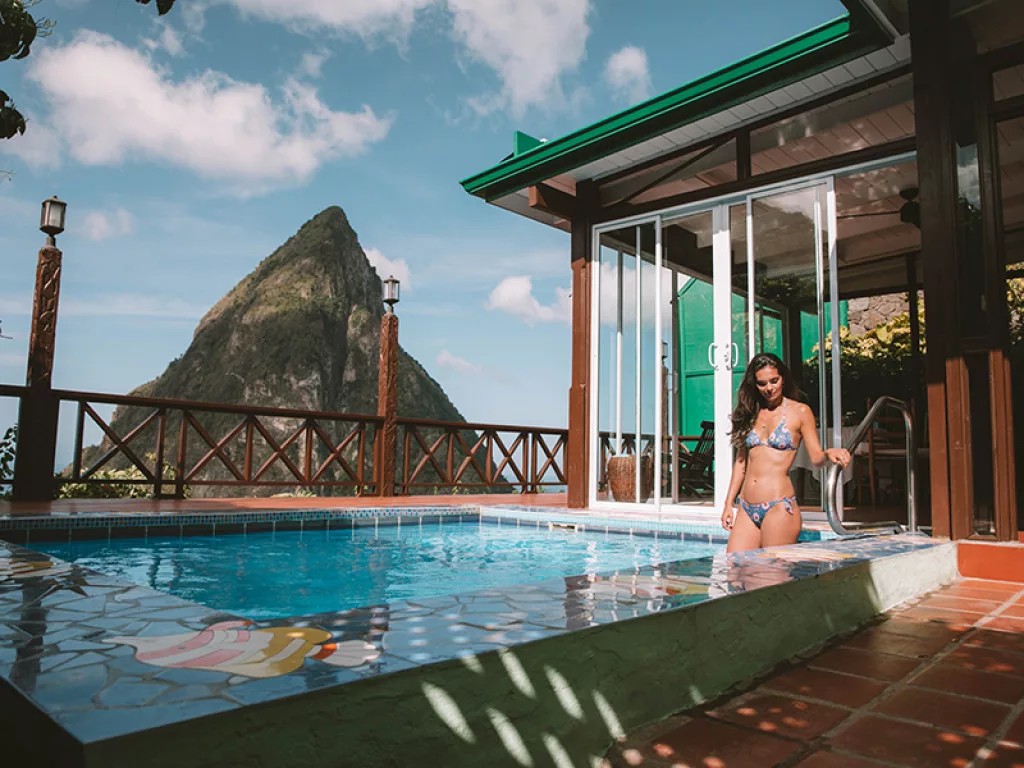
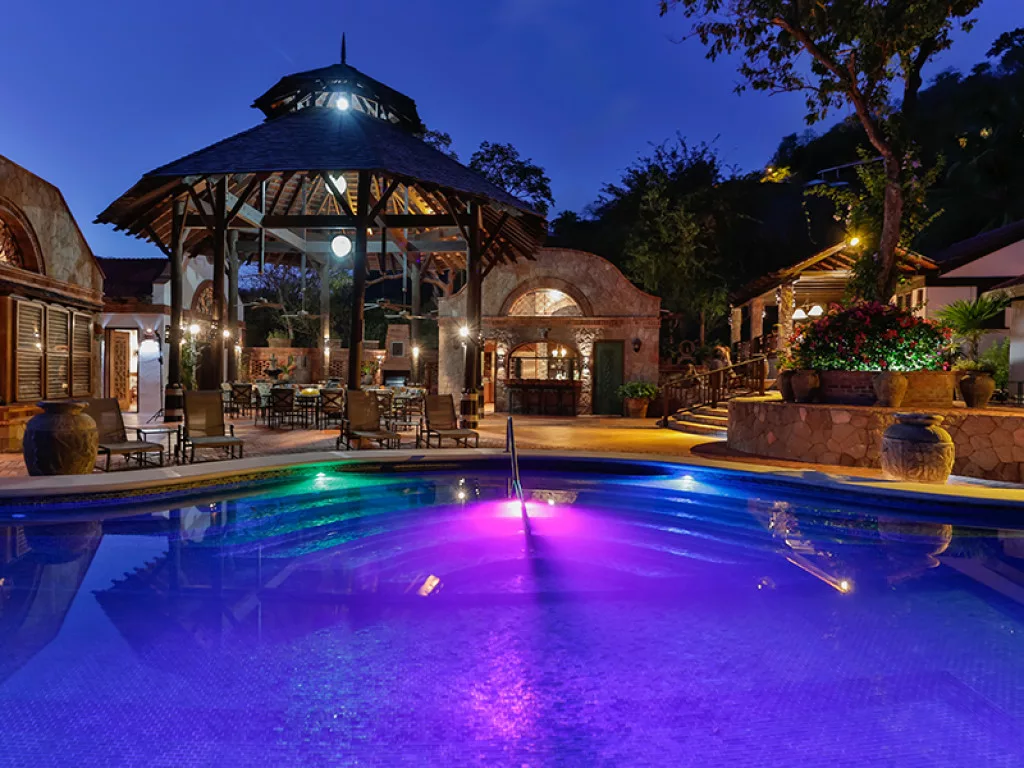
SOUFRIERE IN FOCUS
Castries may be Saint Lucia’s official capital, but the former colonial capital of Soufrière sits at the heart of some of the island’s most loved attractions.
The town takes its name from the sulphur fumes of the nearby volcano, where hot springs, geothermal fields and waterfalls await, and bathing in the volcanic mud promises a rejuvenating healing treatment. The dormant caldera of Qualibou is renowned as the world’s only ‘drive-in’ volcano, allowing you the ultimate access to its steaming sulphur streams.
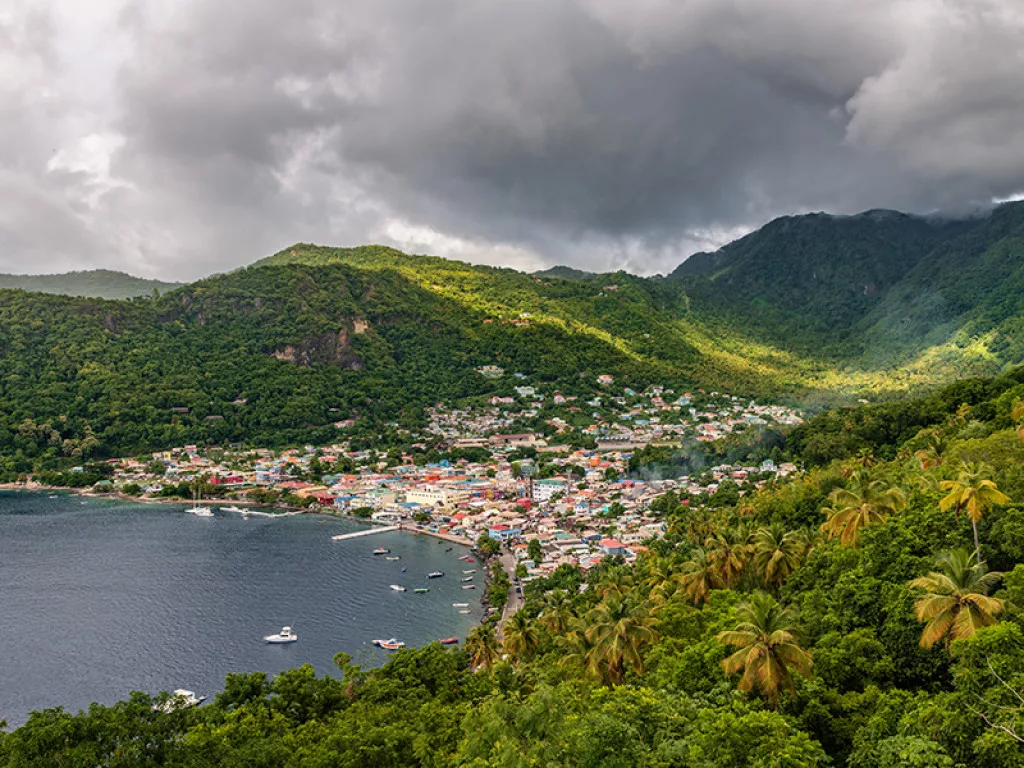
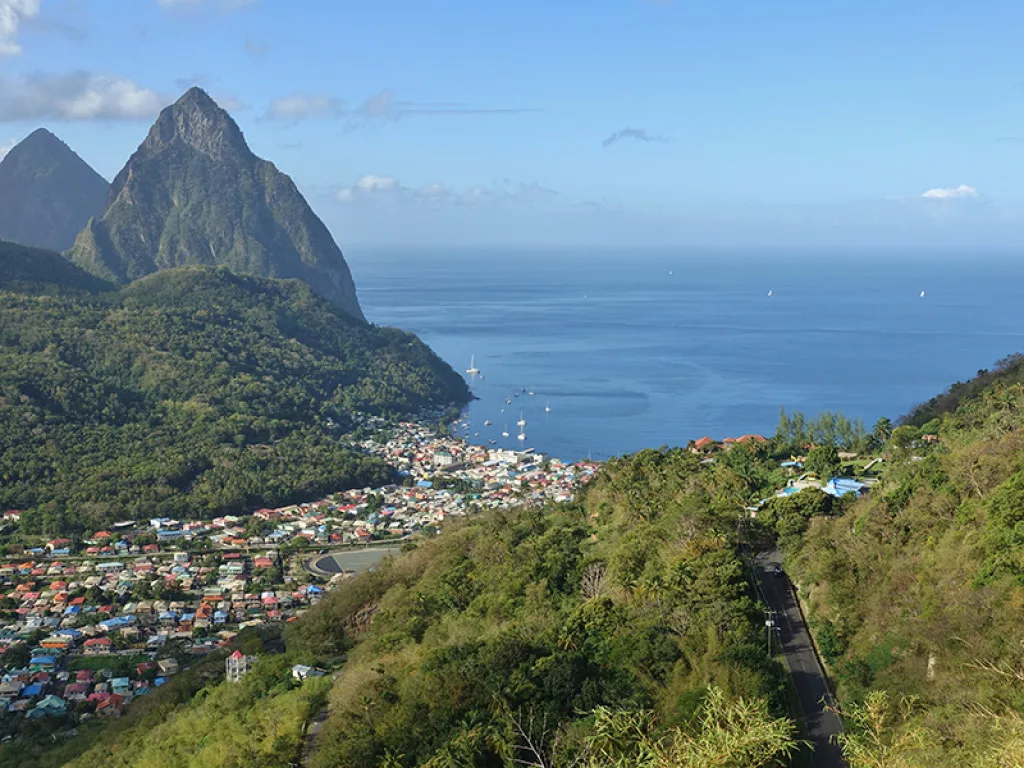
The town itself is a picturesque assemblage of colonial architecture and wooden cottages painted in vibrant colours. The bustling waterfront is also a hive of activity, justifying Soufrière itself as at least a day-trip destination. Ideally positioned in the scenic south, Soufrière is surrounded by centuries-old plantations, such as the still-functioning cacao plantation of the Fond Doux Estate which offers popular walking tours.
Offering hidden beaches and natural wonders, Soufrière’s most obvious draw is its proximity to the two towering Pitons. These scenic pinnacles overlook the town and are flanked by swathes of sandy beach. The daring may choose to hike and climb these conical volcanic spires, savouring a variety of hiking trails that offer unparalleled island views. Below, explore the submarine jungle of coral reefs at the Pitons’ base for some unforgettable snorkelling or diving. Sit back and admire the view on the white sands of Sugar Beach or seek out true seclusion on the quiet shores of Anse Mamin.
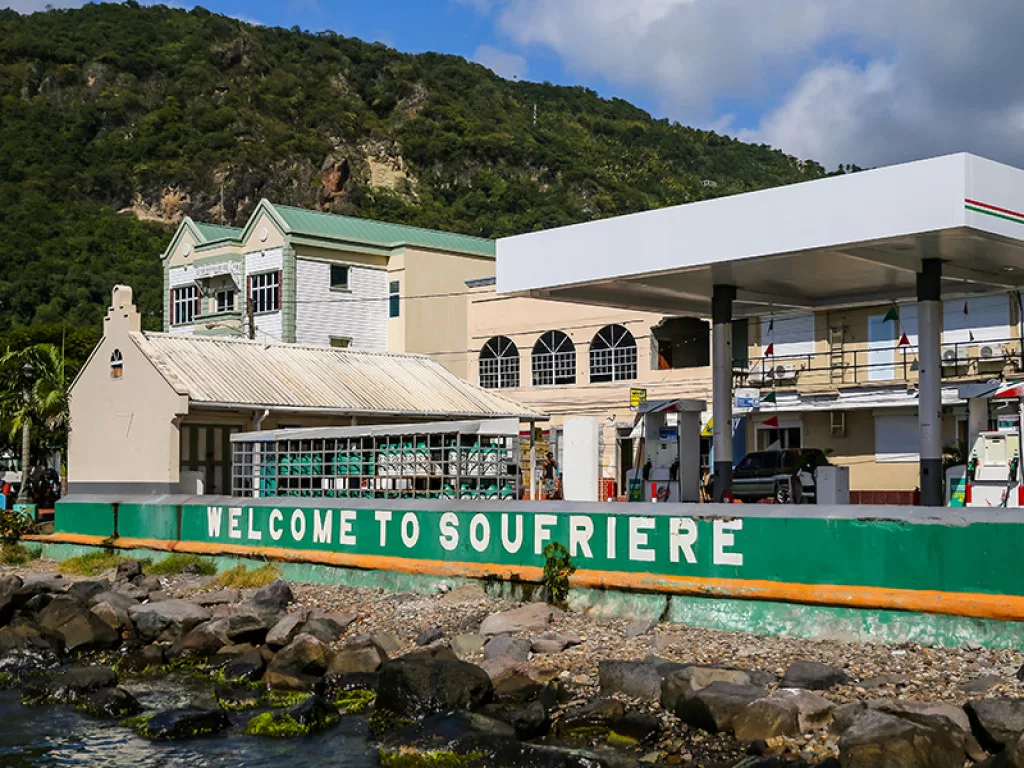
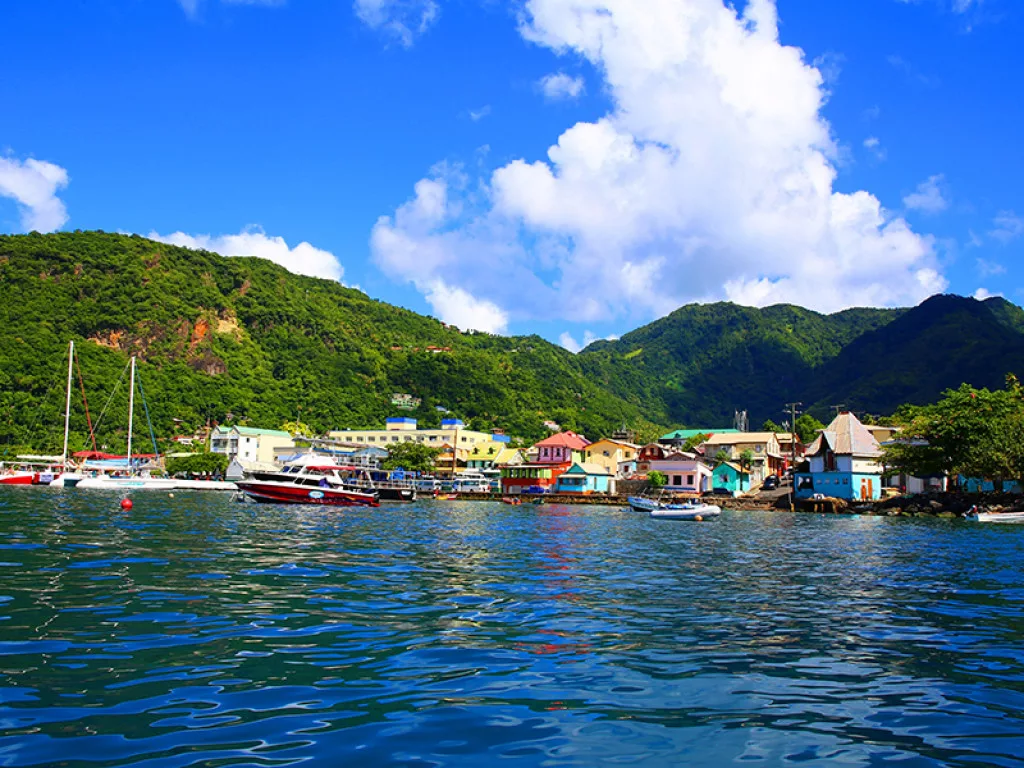
LANDMARK ATTRACTIONS
Gros and Petit Pitons
These two limestone peaks are the most iconic sight in Saint Lucia, commemorated everywhere from beer bottles to local currency. A reminder of the island’s volcanic legacy, the Pitons were officially designated a UNESCO World Heritage site in 2004. Located in a bay near Soufrière, both Pitons can be climbed, or you may prefer to snorkel in the azure waters at their base.
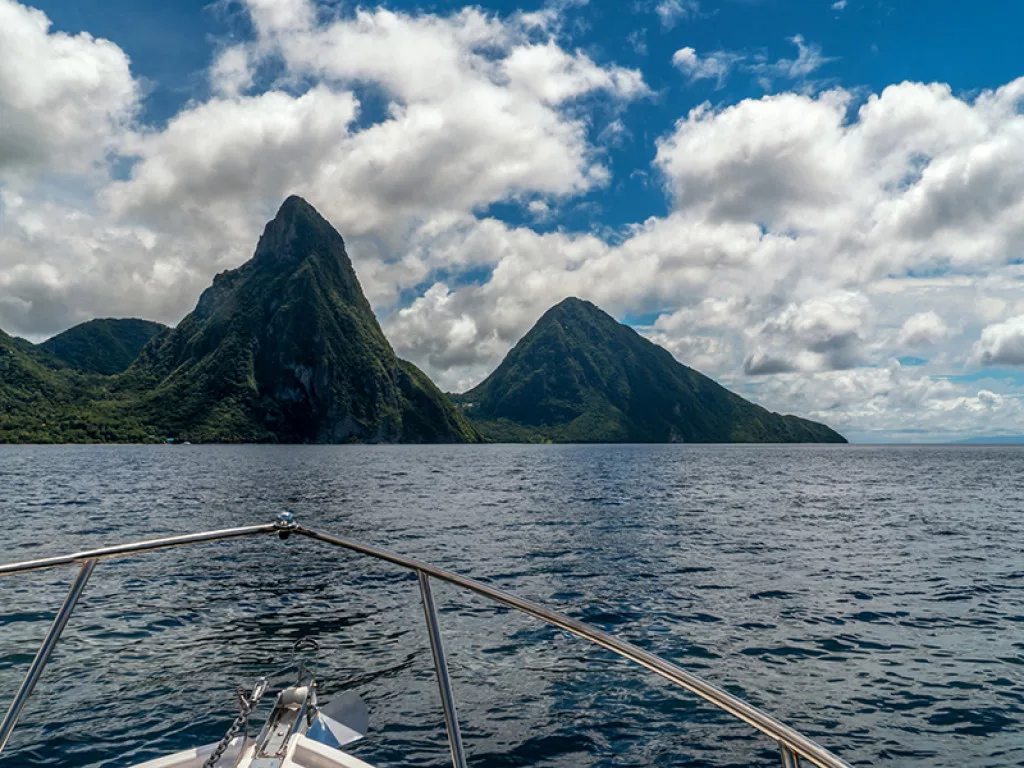
Pigeon Island
A National Park and picturesque islet, Pigeon Island is a gateway to a tumultuous era in Saint Lucia’s history ever since the first European settled here in the 1550s – an enigmatically named Frenchman called Jambe de Bois, or ‘wooden leg’. Dominated by an 18th-century fort, take a tour of ruined military buildings used during the French and British battles for the island and ascend the fort’s lookout point for unbeaten panoramic views.
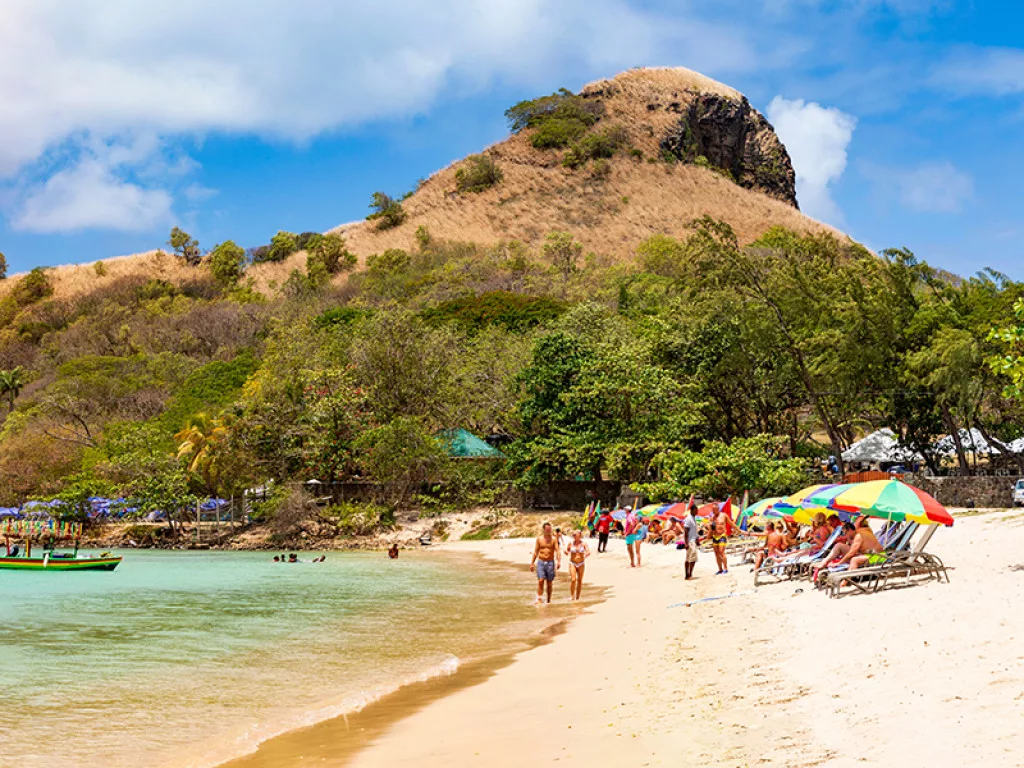
Anse Chastanet
This scenic spot is best known for its coral reef, which is protected as a national marine reserve. The dark-sand beach, nestled against sloping hillsides swathed with jungle, is located on the southwest of the island and is known for its water sports and some of the best snorkelling to be found in Saint Lucia.
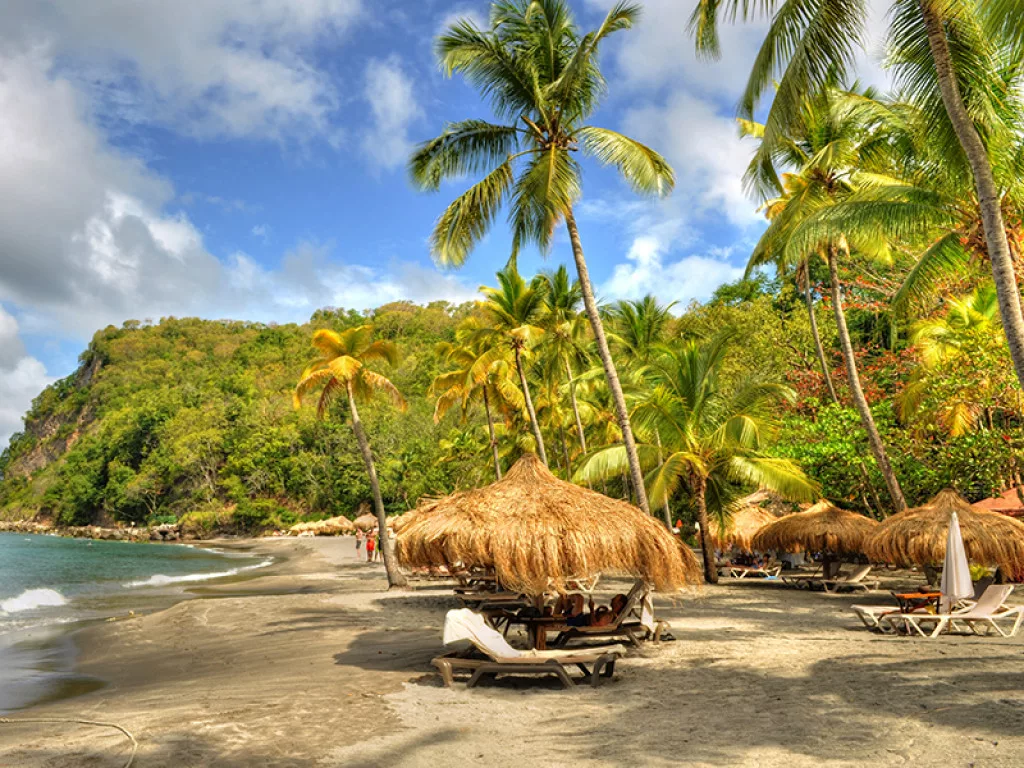
GETTING THERE AND AROUND
Although it is possible to travel from one end of Saint Lucia to the other in under two hours, the island’s interior is one of the most mountainous in the Caribbean. For those keen to venture beyond the confines of their resort, a hire car is the most popular option. A 4WD vehicle is highly recommended, not just for more adventurous excursions, but also since the conditions of the roads can be poor in places – potholes and roadworks are to be expected, as are narrow roads and sharp corners! Most main roads are well-surfaced but can be extremely steep on the West Coast and notoriously pot-holed in the East. Bear in mind, most tourist attractions are a few miles off the main highways where you are likely to encounter steep, rough roads where signposts may be lacking.
All visitors will need to acquire a temporary permit to drive here, which can be obtained at the rental car company, or at the airport’s immigration station. Local minibuses are also an option but are reputed for their lack of a timetable and often cramped conditions. Elsewhere, water taxis are a good way to commute between beaches and waterside villages.
The two primary airports include Hewanorra International Airport in Saint Lucia’s south, or George F.L. Charles Airport in Castries.
